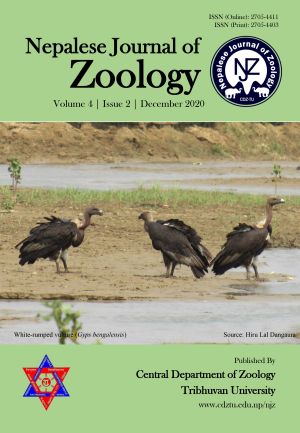Breeding success of the Himalayan griffon (Gyps himalayensis) in Upper Mustang, Nepal
DOI:
https://doi.org/10.3126/njz.v4i2.33891Keywords:
Conservation, Himalayan griffon, Monitoring, Mustang, NestingAbstract
Long-term conservation of the species requires the availability of their natural habitat along with all those factors that support their viability. Understanding the breeding success of vulture and different factors affecting it is important to line up species conservation, although very less is known about the reproductive and behavioral ecology of Himalayan griffon (Gyps himalayensis). Therefore, the present study was carried out in Upper Mustang areas of Nepal, a prime habitat for the species. For the determination of the factors influencing breeding success, exploratory research design was used. Identification of vulture’s nests was done by direct observation. Altogether 78 nests were identified with 41.02% breeding success with occupied nest as the primary unit. Almost all the productive nests were found in steep cliffs facing north direction. Nesting sites were located near water sources. Grazing and noise respectively have positive and negative impacts on the breeding success. Developmental activities like road construction, distribution of power lines is proven threat to vulture as per locals' perception and require development activities to be carried out with proper planning.
Downloads
Downloads
Published
How to Cite
Issue
Section
License
This license enables reusers to distribute, remix, adapt, and build upon the material in any medium or format for noncommercial purposes only, and only so long as attribution is given to the creator.

